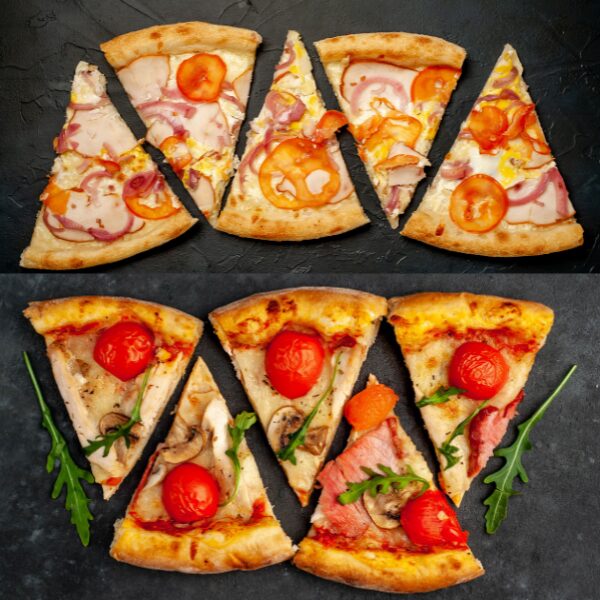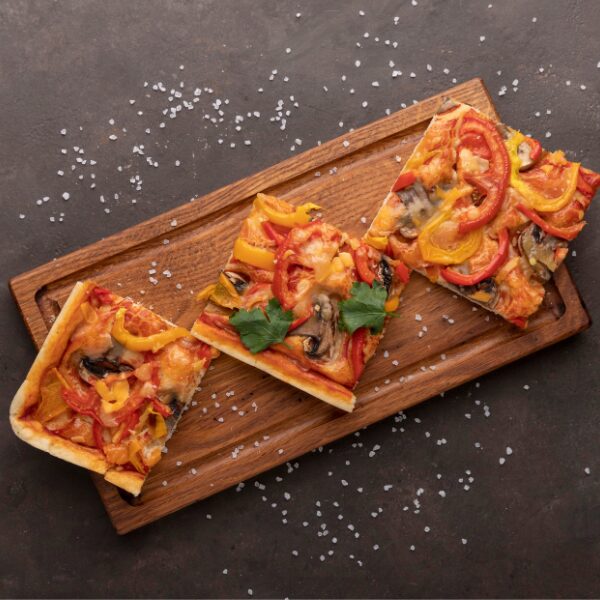Pizza is a beloved culinary creation that originated in Italy and has since become a global favorite. Typically, a pizza consists of a round, flat base of leavened wheat-based dough, topped with tomatoes, cheese, and various other ingredients. Including meats, vegetables, and herbs, all baked together to create a savory, flavorful dish. The number of calories in a slice of pizza can vary widely depending on the type and size of the pizza, as well as the specific toppings used. On average, a standard slice of cheese pizza contains approximately 200-300 calories. However, this can increase significantly with the addition of toppings such as pepperoni, sausage, or extra cheese.
Calories in a slice of pizza: Why Knowing Pizza Calories Matters
Understanding the calories in a slice of pizza is crucial for anyone mindful of their dietary intake. Pizza is a beloved dish worldwide, often enjoyed in social settings, but it can also be a significant source of calories that contribute to weight gain if consumed excessively. By being aware of the calorie content, you can make informed choices that align with your health goals. This knowledge is particularly important for those who are managing their weight, trying to eat more healthily, or monitoring their caloric intake for medical reasons.

Nutritional Breakdown of a Pizza
To comprehend the calories in a slice of pizza, it’s essential to consider its nutritional components. A standard pizza slice typically includes a crust, sauce, cheese, and various toppings. Each of these components contributes differently to the overall calorie count. For instance, a regular slice of cheese pizza can range from 200 to 300 calories, but this number can vary significantly based on the thickness of the crust, the type of cheese, and the amount and variety of toppings. Additionally, pizza provides macronutrients like carbohydrates, proteins, and fats, along with micronutrients such as vitamins and minerals, depending on the ingredients used.
Exploring Different Types of Pizza
Moreover, the calories in a slice of pizza can vary widely depending on the type of pizza. Traditional pizzas like Margherita or Pepperoni have different caloric values compared to specialty pizzas such as BBQ Chicken or Veggie Delight. For example, a slice of Margherita pizza, known for its simplicity, might be lower in calories compared to a meat-laden pizza due to the absence of heavy meats and extra cheese. On the other hand, gourmet pizzas with premium ingredients like truffle oil, prosciutto, or exotic cheeses can be significantly higher in calories. Thus, understanding the type of pizza you are consuming is crucial in managing your caloric intake.
Traditional vs. Specialty Pizzas
Traditional pizzas, like Margherita and Pepperoni, have timeless appeal with their classic flavors. They focus on simplicity, featuring basic ingredients like tomato sauce, mozzarella, and select toppings. Specialty pizzas, on the other hand, offer creative and diverse combinations, incorporating unique ingredients such as exotic cheeses, gourmet meats, and innovative sauces. These pizzas cater to adventurous palates and those seeking a novel culinary experience not focusing on calories in a slice of pizza.
Thin Crust vs. Deep Dish
Thin crust pizzas are celebrated for their crispiness and light texture, providing a balanced ratio of crust to toppings. They bake quickly and offer a straightforward, often less filling meal. Deep-dish pizzas are known for their thick, doughy crusts that cradle generous layers of cheese, sauce, and toppings. Thus, making for a hearty, indulgent meal having multiple calories in a slice of pizza. This style is synonymous with a rich, comforting dining experience.
Meat Lovers vs. Veggie Delight
Meat lovers’ pizzas are a carnivore’s delight, loaded with various meats like pepperoni, sausage, bacon, and ham. These pizzas are robust and savory, appealing to those who enjoy rich, hearty flavors unconcerned about calories in a slice of pizza. Veggie delight pizzas prioritize fresh vegetables such as bell peppers, mushrooms, onions, and spinach. They offer a lighter, healthier option, emphasizing crisp, vibrant flavors and catering to vegetarian and health-conscious diners.
Examining Crust Variations of a Pizza
Transitioning to another vital aspect, the type of crust greatly impacts the calories in a slice of pizza. Traditional thick crusts are often higher in calories compared to thin crusts due to the increased amount of dough. A slice of deep-dish pizza can contain over 400 calories, whereas a thin-crust slice might be around 200-250 calories.
Classic Crust
Classic crust is a traditional pizza base, characterized by its balanced texture – neither too thick nor too thin. It provides a perfect foundation for a variety of toppings, delivering a satisfying crunch with every bite.
Stuffed Crust
Stuffed crust pizza features an extra layer of cheese or other fillings baked into the outer edge of the crust. This indulgent option adds a gooey surprise to every slice, making the crust a flavorful highlight.
Gluten-Free Crust
Gluten-free crust is made without wheat, suitable for those with gluten intolerance or celiac disease. It often incorporates alternative flours like rice, almond, or tapioca, maintaining a crispy texture while being gentle on the stomach.
Cauliflower Crust
Cauliflower crust is a low-carb, vegetable-based alternative to traditional pizza crusts. It’s made by combining grated cauliflower with cheese and eggs, resulting in a nutritious, gluten-free option that offers a subtle, unique flavor. Additionally, modern variations like cauliflower crusts offer a lower-calorie alternative for those seeking to reduce their carbohydrate intake. Whole grain or whole wheat crusts might also provide more fiber and nutrients, contributing to a more balanced diet without significantly increasing calorie intake.
Analyzing Sauce and Toppings Impact
Furthermore, the sauce and toppings used on pizza are key factors in determining the calories in a slice of pizza. A standard tomato-based sauce is relatively low in calories, but creamy sauces like Alfredo or Pesto can add substantial calories due to their higher fat content. When it comes to toppings, vegetables like bell peppers, onions, and mushrooms are low in calories and high in nutrients, making them excellent choices for a healthier pizza.

Cheese Options Impact
The choice of cheese can significantly alter the flavor and texture of a pizza, with options like mozzarella providing a classic stretchiness, while goat cheese or blue cheese adds a distinctive tang. Varying cheeses can also influence the richness and creaminess, enhancing the overall eating experience.
Meat Topping Impact
Meat toppings such as pepperoni, sausage, or bacon add savory, umami flavors and a satisfying protein boost. They can also introduce varying textures, from the crispiness of bacon to the heartiness of sausage, making each bite more robust and filling.
Vegetable Toppings Impact
Vegetable toppings bring freshness, color, and a range of flavors, from the sweetness of bell peppers to the earthiness of mushrooms. They can lighten a pizza, add a crunch or juiciness, and provide nutritional benefits, balancing the richness of cheese and meats.
Uncovering Hidden Calories of a Pizza
Additionally, it’s important to uncover the hidden calories in a slice of pizza that might not be immediately obvious. Extra ingredients like dipping sauces, stuffed crusts, or added oils and butter can drastically increase the calorie count. For example, garlic butter dipping sauce or a cheese-stuffed crust can add hundreds of extra calories to your meal. Similarly, the cooking method can also play a role; pizzas baked with additional oils or greased pans will have higher calorie content compared to those baked on parchment paper or a lightly greased surface. Being mindful of these hidden calories can help you make better dietary choices.
Tips for Making Healthier Pizza Choices
Finally, here are some tips for making healthier pizza choices while still enjoying your favorite food. First, opt for a thin crust to reduce the calories in a slice of pizza. Secondly, choose a tomato-based sauce instead of cream-based sauces. Thirdly, load up on vegetable toppings which are lower in calories and higher in nutrients. Additionally, you can ask for less cheese or choose part-skim cheese to reduce fat and calorie intake. Moreover, consider making pizza at home where you can control the ingredients and portions more effectively. This way, you can enjoy a delicious pizza without worrying about the calories in a slice of pizza.
Pizza at CupsnChai, Canton, MI
CupsnChai is a modern cafe located in Michigan. We have a variety of pizza flavors that you can treat your tastebuds with, including but not limited to:
- Cheese Pizza
- BBQ Chicken Pizza
- Chutney Chicken Pizza
- Achari Chicken Pizza
- Reshmi Kabob Pizza
- Chatpata Veggie Pizza
- Chilli Paneer Pizza
Wrapping It Up
In conclusion, understanding the calories in a slice of pizza and how different factors affect them can help you enjoy this popular dish without compromising your health goals. Furthermore, by being mindful of the type of crust, sauce, toppings, and additional hidden calories. Furthermore, you can make informed choices that support a balanced diet. Remember, enjoying pizza in moderation and making healthier choices can allow you to savor your favorite food while staying on track with your nutritional goals.
FAQs
How do different types of pizza crusts impact calorie count?
Thicker and stuffed crusts generally have higher calorie counts compared to thin or regular crusts.
How many calories are there in a slice of pizza with pepperoni?
A slice of pepperoni pizza typically has about 300-400 calories, depending on size and crust type.
Where can I find pizza in Canton, MI?
You can find pizza in Canton, MI, at CupsnChai.
Which pizza toppings tend to be higher in calories?
High-calorie pizza toppings include extra cheese, pepperoni, sausage, and bacon.



